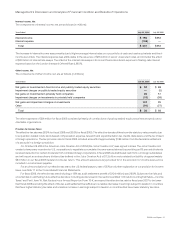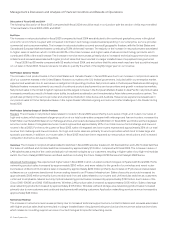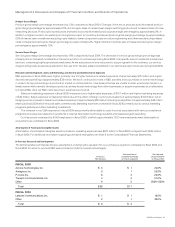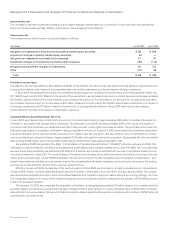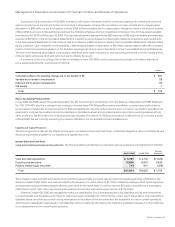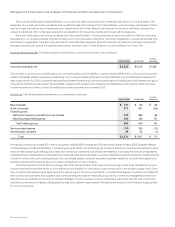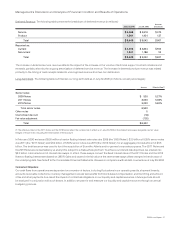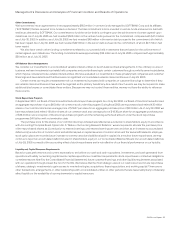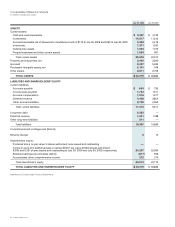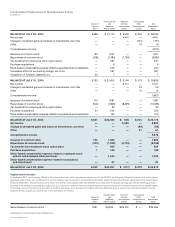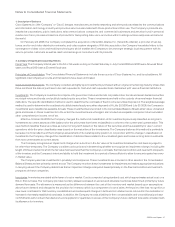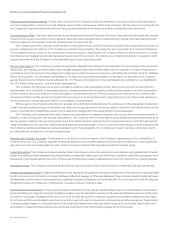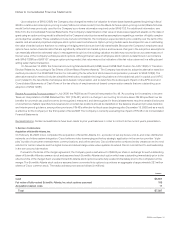Cisco 2006 Annual Report Download - page 38
Download and view the complete annual report
Please find page 38 of the 2006 Cisco annual report below. You can navigate through the pages in the report by either clicking on the pages listed below, or by using the keyword search tool below to find specific information within the annual report. 2006 Annual Report 41
Our equity portfolio consists of securities with characteristics that most closely match the Standard & Poor’s 500 Index or NASDAQ
Composite Index. These equity securities are held for purposes other than trading. Our impairment charge on certain publicly traded equity
securities was $5 million during scal 2005. The impairment charge was related to the decline in the fair value of certain publicly traded
equity securities below their cost basis that were judged to be other-than-temporary. There were no impairment charges on publicly traded
equity securities in scal 2006 or scal 2004.
Investments in Privately Held Companies
We have invested in privately held companies, some of which are in the startup or development stages. These investments are inherently
risky because the markets for the technologies or products these companies are developing are typically in the early stages and may
never materialize. We could lose our entire initial investment in these companies. These investments are primarily carried at cost, which as
of July 29, 2006 was $574 million, compared with $421 million at July 30, 2005, and are recorded in other assets in the Consolidated Balance
Sheets. Our impairment charges on investments in privately held companies were $15 million, $39 million, and $112 million during scal 2006,
2005, and 2004, respectively.
Our evaluation of investments in private and public companies is based on the fundamentals of the businesses, including, among other
factors, the nature of their technologies and potential for nancial return.
Long-Term Debt
At any time, a sharp fall in interest rates could have a material adverse impact on the fair value of $6.0 billion of our xed-rate debt. Conversely,
a sharp rise in interest rates could have a material favorable impact. We have entered into $6.0 billion notional amount of interest rate swaps
designated as fair value hedges, and gains and losses in the fair value of these swaps offset changes in the fair value of the xed-rate debt.
In effect, these swaps convert the xed interest rates to oating interest rates based on LIBOR. A sharp change in rates would not have a
material impact on the fair value of our $500 million variable-rate debt.
A sharp rise in short-term interest rates could have a material adverse impact on interest expense, while a sharp fall in short-term rates
could have a material favorable impact. To mitigate these impacts, we presently invest a portion of our interest-bearing assets in instruments
with similar interest rate characteristics as the swapped debt.
Derivative Instruments
Foreign Currency Derivatives
We enter into foreign exchange forward contracts to reduce the short-term effects of foreign currency uctuations on receivables, investments,
and payables, primarily denominated in Australian, Canadian, Japanese, and several European currencies, including the euro and British
pound. Our market risks associated with our foreign currency receivables, investments, and payables relate primarily to variances from our
forecasted foreign currency transactions and balances.
Approximately 75% of our operating expenses are U.S.-dollar denominated. To reduce variability in operating expenses caused by the
remaining non-U.S.-dollar denominated operating expenses, we periodically hedge certain foreign currency forecasted transactions with
currency options and forward contracts with maturities up to 18 months. These hedging programs are not designed to provide foreign
currency protection over longer time horizons. In designing a specic hedging approach, we consider several factors, including offsetting
exposures, signicance of exposures, costs associated with entering into a particular hedge instrument, and potential effectiveness of the
hedge. The gains and losses on foreign exchange contracts mitigate the variability in operating expenses associated with currency movements.
Primarily because of our limited currency exposure to date, the effect of foreign currency uctuations has not been material to our Consolidated
Financial Statements. The effect of foreign currency uctuations, net of hedging, decreased total research and development, sales and
marketing, and general and administrative expenses by approximately 0.5% in scal 2006 compared with scal 2005 and increased total
research and development, sales and marketing, and general and administrative expenses by approximately 2% in scal 2005 compared
with scal 2004. The impact of foreign currency uctuations on sales has not been material because our sales are primarily denominated
in U.S. dollars.
Quantitative and Qualitative Disclosures About Market Risk


